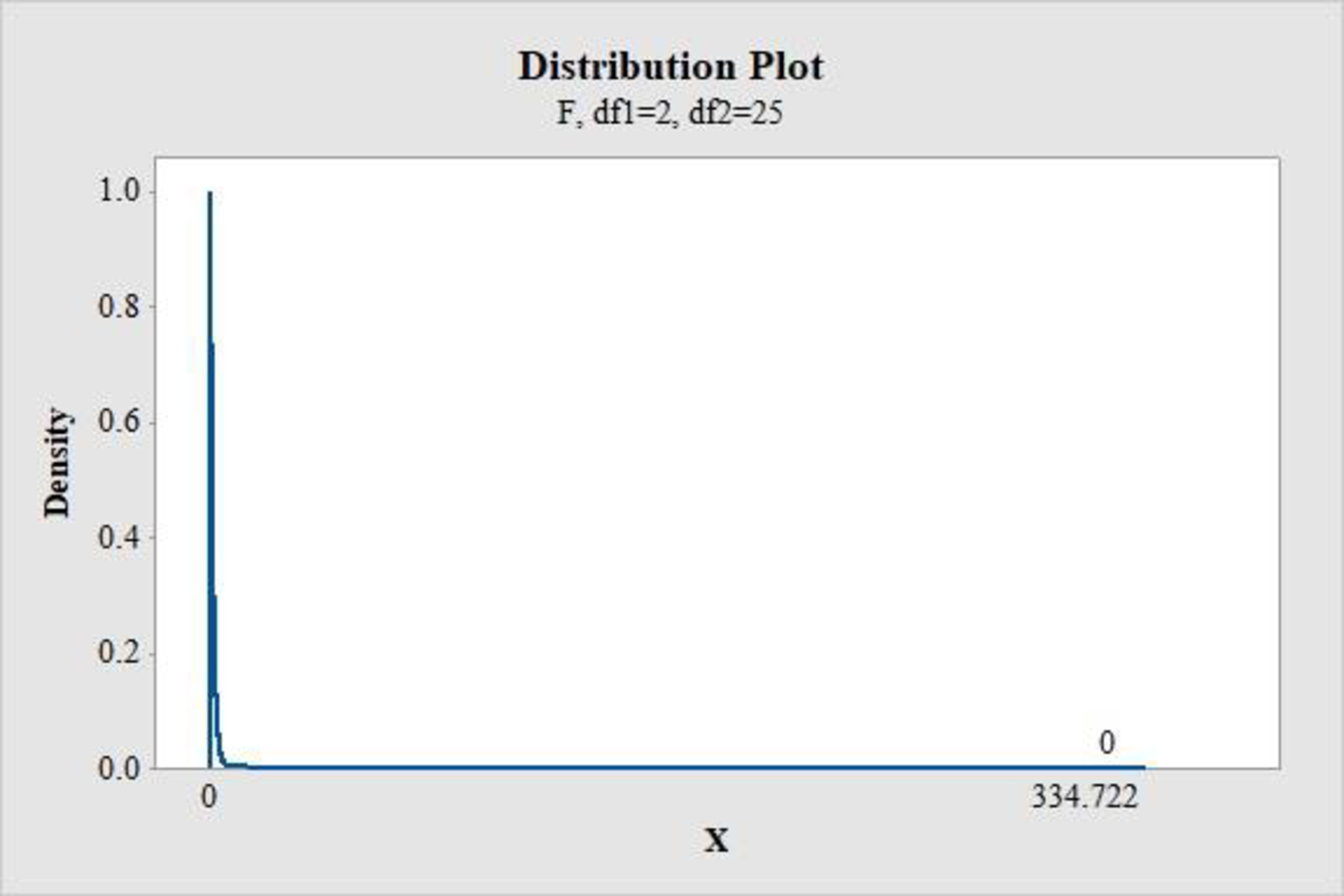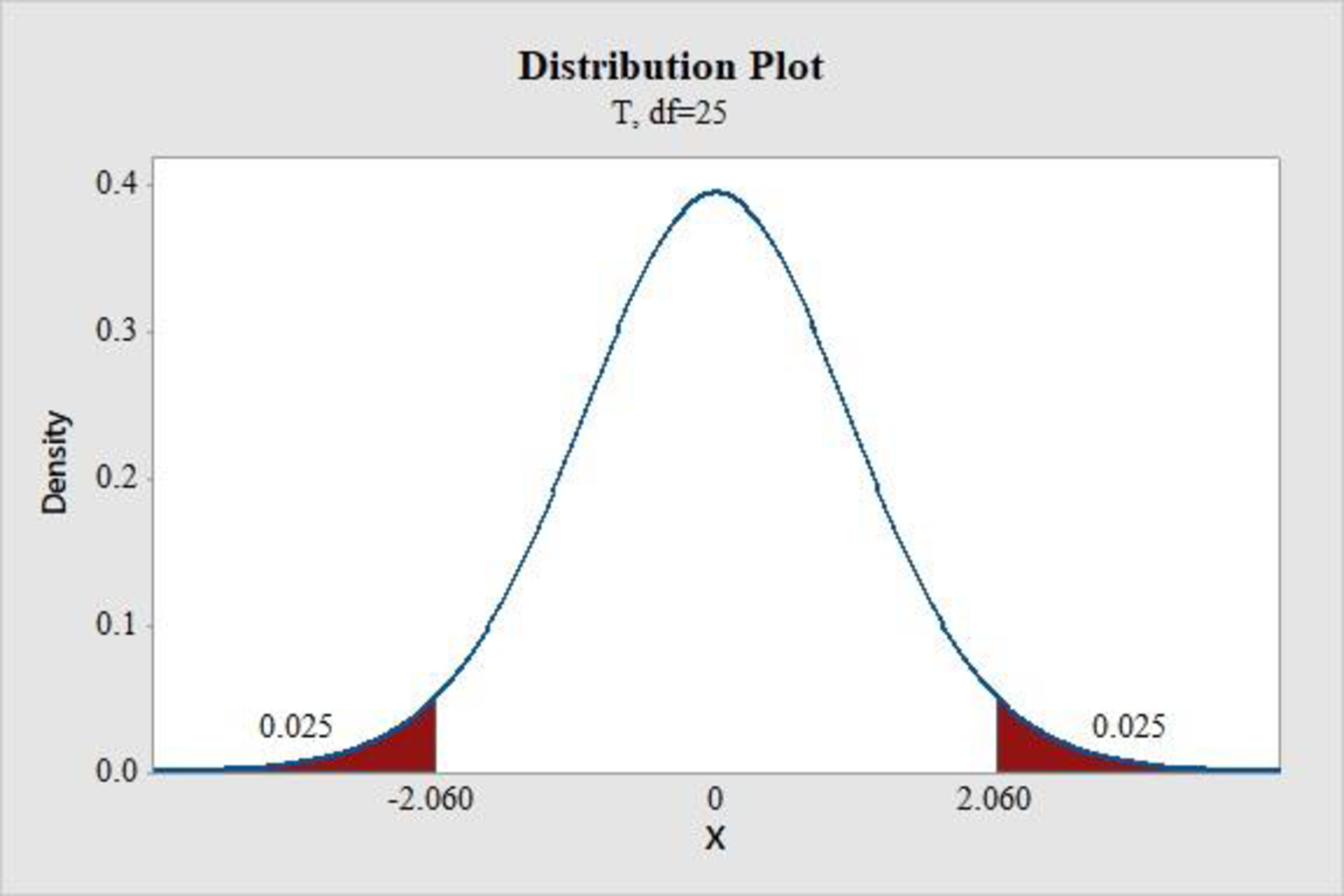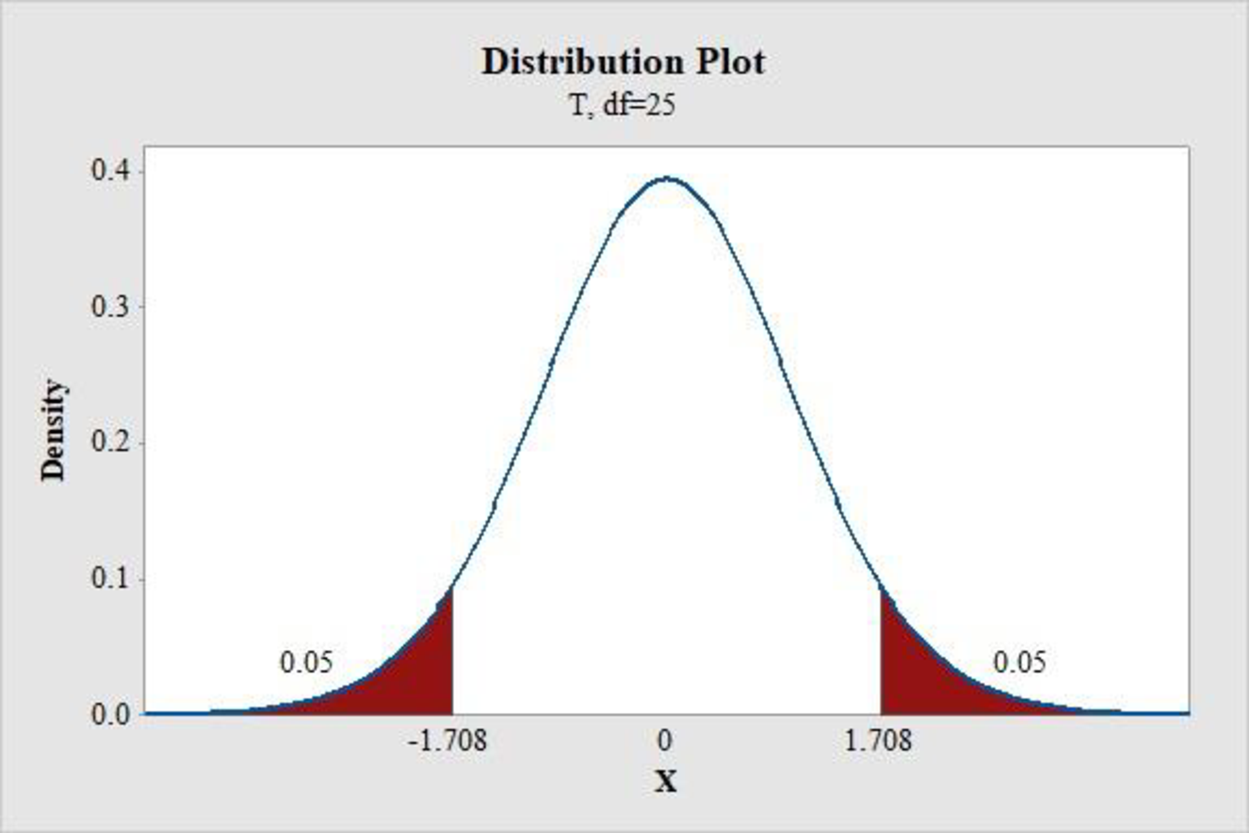
a.
Test whether the given model is useful or not at the 0.05 level of significance.
a.
Answer to Problem 46E
There is convincing evidence that the given model is useful at the 0.05 level of significance.
Explanation of Solution
Calculation:
It is given that the variable y is absorption,
1.
The model is
2.
Null hypothesis:
That is, there is no useful relationship between y and any of the predictors.
3.
Alternative hypothesis:
That is, there is a useful relationship between y and any of the predictors.
4.
Here, the significance level is
5.
Test statistic:
Here, n is the sample size, and k is the number of variables in the model.
6.
Assumptions:
Since there is no availability of original data to check the assumptions, there is a need to assume that the variables are related to the model, and the random deviation is distributed normally with mean 0 and the fixed standard deviation.
7.
Calculation:
From the MINITAB output, the value of
The value of F-test statistic is calculated as follows:
8.
P-value:
Software procedure:
Step-by-step procedure to find the P-value using the MINITAB software:
- Choose Graph > Probability Distribution Plot choose View Probability > OK.
- From Distribution, choose ‘F’ distribution.
- Enter the Numerator df as 2 and Denominator df as 25.
- Click the Shaded Area tab.
- Choose X Value and Right Tail for the region of the curve to shade.
- Enter the X value as 334.722.
- Click OK.
Output obtained using the MINITAB software is represented as follows:

From the MINITAB output, the P-value is 0.
9.
Conclusion:
If the
Therefore, the P-value of 0 is less than the 0.05 level of significance.
Hence, reject the null hypothesis.
Thus, there is convincing evidence that the given model is useful at the 0.05 level of significance.
b.
Calculate a 95% confidence interval for
b.
Answer to Problem 46E
The 95% confidence interval for
Explanation of Solution
Calculation:
Here,
Since there is no availability of original data to check the assumptions, there is a need to assume that the variables are related to the model, and the random deviation is distributed normally with mean 0 and the fixed standard deviation.
The formula for confidence interval for
Where,
Degrees of freedom:
Software procedure:
Step-by-step procedure to find the P-value using the MINITAB software:
- Choose Graph > Probability Distribution Plot choose View Probability > OK.
- From Distribution, choose ‘t’ distribution.
- Enter the Degrees of freedom as 25.
- Click the Shaded Area tab.
- Choose Probability and Both for the region of the curve to shade.
- Enter the Probability value as 0.05.
- Click OK.
Output obtained using the MINITAB software is represented as follows:

From the MINITAB output, the critical value is 2.060.
From the given MINITAB output, the value of
The confidence interval for mean change in exam score is calculated as follows:
Thus, the 95% confidence interval for
There is 95% confident that the average increase in y is associated with 1-unit increase in starch damage that is between 0.298 and 0.373, when the other predictors are fixed.
c.
- i. Test the hypothesis
H 0 : β 1 = 0 H a : β 1 ≠ 0
- ii. Test the hypothesis
H 0 : β 2 = 0 H a : β 2 ≠ 0
c.
Answer to Problem 46E
It can be concluded that the quadratic term should not be eliminated from the model and simple linear model should not be sufficient.
Explanation of Solution
Calculation:
i.
1.
The predictor
2.
Null hypothesis:
3.
Alternative hypothesis:
4.
Here, the common significance levels are
5.
Test statistic:
Here,
6.
Assumptions:
The random deviations from the values by the population regression equation are distributed normally with mean 0 and fixed standard deviation.
7.
Calculation:
From the MINITAB output, the t test statistic value of
8.
P-value:
From the MINITAB output, the P-value for
9.
Conclusion:
If the
Therefore, the P-value of 0 is less than any common levels of significance, such as 0.05, 0.01, and 0.10.
Hence, reject the null hypothesis.
Thus, there is convincing evidence that the flour protein variable is important and it is
ii.
1.
The predictor
2.
Null hypothesis:
3.
Alternative hypothesis:
4.
Here, the common significance levels are
5.
Test statistic:
Here,
6.
Assumptions:
The random deviations from the values by the population regression equation are distributed normally with mean 0 and fixed standard deviation.
7.
Calculation:
From the MINITAB output, the t test statistic value of
8.
P-value:
From the MINITAB output, the P-value for
9.
Conclusion:
If the
Therefore, the P-value of 0 is less than any common levels of significance, such as 0.05, 0.01, and 0.10.
Hence, reject the null hypothesis.
Thus, there is convincing evidence that the starch damage variable is important and it is
d.
Explain whether both the independent variables are important or not.
d.
Explanation of Solution
From the results of Part (c), there is evidence that the variables of flour protein and starch damage are important.
e.
Calculate a 90% confidence interval and interpret it.
e.
Answer to Problem 46E
The 90% confidence interval is
Explanation of Solution
Calculation:
It is given that the value of
Assume that the exam score is associated with the predictors according to the model. The random deviations from the values by the population regression equation are distributed normally with mean 0 and fixed standard deviation.
The formula for prediction interval for mean y value is as follows:
The value of
Degrees of freedom:
Software procedure:
Step-by-step procedure to find the P-value using the MINITAB software:
- Choose Graph > Probability Distribution Plot choose View Probability > OK.
- From Distribution, choose ‘t’ distribution.
- Enter the Degrees of freedom as 25.
- Click the Shaded Area tab.
- Choose Probability and Both for the region of the curve to shade.
- Enter the Probability value as 0.10.
- Click OK.
Output obtained using the MINITAB software is represented as follows:

From the MINITAB output, the critical value is 1.708.
The prediction interval for mean y value is calculated as follows:
Thus, the 90% confidence interval is
There is 90% confident that the mean water absorption for wheat with 11.7 flour protein and 57 starch damage is between 54.5084 and 56.2916.
f.
Predict the water absorption for the shipment by 90% interval.
f.
Answer to Problem 46E
The water absorption values for the particular shipment are between 53.3297 and 57.4703 by 90% prediction interval.
Explanation of Solution
Calculation:
It is given that the value of
Assume that the exam score is associated with the predictors according to the model. The random deviations from the values by the population regression equation are distributed normally with mean 0 and fixed standard deviation.
The formula for prediction interval for mean y value is as follows:
From the given MINITAB output, the standard deviation is 1.094.
From Part e., the value of
From the MINITAB output in Part e., the critical value is 1.708.
The prediction interval for water absorption for shipment is calculated as follows:
Thus, the 90% prediction interval is
By prediction at 90% interval, the water absorption values for the particular shipment are between 53.3297 and 57.4703.
Want to see more full solutions like this?
Chapter 14 Solutions
INTRODUCTION TO STATISTICS & DATA ANALYS
- ons 12. A sociologist hypothesizes that the crime rate is higher in areas with higher poverty rate and lower median income. She col- lects data on the crime rate (crimes per 100,000 residents), the poverty rate (in %), and the median income (in $1,000s) from 41 New England cities. A portion of the regression results is shown in the following table. Standard Coefficients error t stat p-value Intercept -301.62 549.71 -0.55 0.5864 Poverty 53.16 14.22 3.74 0.0006 Income 4.95 8.26 0.60 0.5526 a. b. Are the signs as expected on the slope coefficients? Predict the crime rate in an area with a poverty rate of 20% and a median income of $50,000. 3. Using data from 50 workarrow_forward2. The owner of several used-car dealerships believes that the selling price of a used car can best be predicted using the car's age. He uses data on the recent selling price (in $) and age of 20 used sedans to estimate Price = Po + B₁Age + ε. A portion of the regression results is shown in the accompanying table. Standard Coefficients Intercept 21187.94 Error 733.42 t Stat p-value 28.89 1.56E-16 Age -1208.25 128.95 -9.37 2.41E-08 a. What is the estimate for B₁? Interpret this value. b. What is the sample regression equation? C. Predict the selling price of a 5-year-old sedan.arrow_forwardian income of $50,000. erty rate of 13. Using data from 50 workers, a researcher estimates Wage = Bo+B,Education + B₂Experience + B3Age+e, where Wage is the hourly wage rate and Education, Experience, and Age are the years of higher education, the years of experience, and the age of the worker, respectively. A portion of the regression results is shown in the following table. ni ogolloo bash 1 Standard Coefficients error t stat p-value Intercept 7.87 4.09 1.93 0.0603 Education 1.44 0.34 4.24 0.0001 Experience 0.45 0.14 3.16 0.0028 Age -0.01 0.08 -0.14 0.8920 a. Interpret the estimated coefficients for Education and Experience. b. Predict the hourly wage rate for a 30-year-old worker with four years of higher education and three years of experience.arrow_forward
- 1. If a firm spends more on advertising, is it likely to increase sales? Data on annual sales (in $100,000s) and advertising expenditures (in $10,000s) were collected for 20 firms in order to estimate the model Sales = Po + B₁Advertising + ε. A portion of the regression results is shown in the accompanying table. Intercept Advertising Standard Coefficients Error t Stat p-value -7.42 1.46 -5.09 7.66E-05 0.42 0.05 8.70 7.26E-08 a. Interpret the estimated slope coefficient. b. What is the sample regression equation? C. Predict the sales for a firm that spends $500,000 annually on advertising.arrow_forwardCan you help me solve problem 38 with steps im stuck.arrow_forwardHow do the samples hold up to the efficiency test? What percentages of the samples pass or fail the test? What would be the likelihood of having the following specific number of efficiency test failures in the next 300 processors tested? 1 failures, 5 failures, 10 failures and 20 failures.arrow_forward
- The battery temperatures are a major concern for us. Can you analyze and describe the sample data? What are the average and median temperatures? How much variability is there in the temperatures? Is there anything that stands out? Our engineers’ assumption is that the temperature data is normally distributed. If that is the case, what would be the likelihood that the Safety Zone temperature will exceed 5.15 degrees? What is the probability that the Safety Zone temperature will be less than 4.65 degrees? What is the actual percentage of samples that exceed 5.25 degrees or are less than 4.75 degrees? Is the manufacturing process producing units with stable Safety Zone temperatures? Can you check if there are any apparent changes in the temperature pattern? Are there any outliers? A closer look at the Z-scores should help you in this regard.arrow_forwardNeed help pleasearrow_forwardPlease conduct a step by step of these statistical tests on separate sheets of Microsoft Excel. If the calculations in Microsoft Excel are incorrect, the null and alternative hypotheses, as well as the conclusions drawn from them, will be meaningless and will not receive any points. 4. One-Way ANOVA: Analyze the customer satisfaction scores across four different product categories to determine if there is a significant difference in means. (Hints: The null can be about maintaining status-quo or no difference among groups) H0 = H1=arrow_forward
- Please conduct a step by step of these statistical tests on separate sheets of Microsoft Excel. If the calculations in Microsoft Excel are incorrect, the null and alternative hypotheses, as well as the conclusions drawn from them, will be meaningless and will not receive any points 2. Two-Sample T-Test: Compare the average sales revenue of two different regions to determine if there is a significant difference. (Hints: The null can be about maintaining status-quo or no difference among groups; if alternative hypothesis is non-directional use the two-tailed p-value from excel file to make a decision about rejecting or not rejecting null) H0 = H1=arrow_forwardPlease conduct a step by step of these statistical tests on separate sheets of Microsoft Excel. If the calculations in Microsoft Excel are incorrect, the null and alternative hypotheses, as well as the conclusions drawn from them, will be meaningless and will not receive any points 3. Paired T-Test: A company implemented a training program to improve employee performance. To evaluate the effectiveness of the program, the company recorded the test scores of 25 employees before and after the training. Determine if the training program is effective in terms of scores of participants before and after the training. (Hints: The null can be about maintaining status-quo or no difference among groups; if alternative hypothesis is non-directional, use the two-tailed p-value from excel file to make a decision about rejecting or not rejecting the null) H0 = H1= Conclusion:arrow_forwardPlease conduct a step by step of these statistical tests on separate sheets of Microsoft Excel. If the calculations in Microsoft Excel are incorrect, the null and alternative hypotheses, as well as the conclusions drawn from them, will be meaningless and will not receive any points. The data for the following questions is provided in Microsoft Excel file on 4 separate sheets. Please conduct these statistical tests on separate sheets of Microsoft Excel. If the calculations in Microsoft Excel are incorrect, the null and alternative hypotheses, as well as the conclusions drawn from them, will be meaningless and will not receive any points. 1. One Sample T-Test: Determine whether the average satisfaction rating of customers for a product is significantly different from a hypothetical mean of 75. (Hints: The null can be about maintaining status-quo or no difference; If your alternative hypothesis is non-directional (e.g., μ≠75), you should use the two-tailed p-value from excel file to…arrow_forward
 MATLAB: An Introduction with ApplicationsStatisticsISBN:9781119256830Author:Amos GilatPublisher:John Wiley & Sons Inc
MATLAB: An Introduction with ApplicationsStatisticsISBN:9781119256830Author:Amos GilatPublisher:John Wiley & Sons Inc Probability and Statistics for Engineering and th...StatisticsISBN:9781305251809Author:Jay L. DevorePublisher:Cengage Learning
Probability and Statistics for Engineering and th...StatisticsISBN:9781305251809Author:Jay L. DevorePublisher:Cengage Learning Statistics for The Behavioral Sciences (MindTap C...StatisticsISBN:9781305504912Author:Frederick J Gravetter, Larry B. WallnauPublisher:Cengage Learning
Statistics for The Behavioral Sciences (MindTap C...StatisticsISBN:9781305504912Author:Frederick J Gravetter, Larry B. WallnauPublisher:Cengage Learning Elementary Statistics: Picturing the World (7th E...StatisticsISBN:9780134683416Author:Ron Larson, Betsy FarberPublisher:PEARSON
Elementary Statistics: Picturing the World (7th E...StatisticsISBN:9780134683416Author:Ron Larson, Betsy FarberPublisher:PEARSON The Basic Practice of StatisticsStatisticsISBN:9781319042578Author:David S. Moore, William I. Notz, Michael A. FlignerPublisher:W. H. Freeman
The Basic Practice of StatisticsStatisticsISBN:9781319042578Author:David S. Moore, William I. Notz, Michael A. FlignerPublisher:W. H. Freeman Introduction to the Practice of StatisticsStatisticsISBN:9781319013387Author:David S. Moore, George P. McCabe, Bruce A. CraigPublisher:W. H. Freeman
Introduction to the Practice of StatisticsStatisticsISBN:9781319013387Author:David S. Moore, George P. McCabe, Bruce A. CraigPublisher:W. H. Freeman





